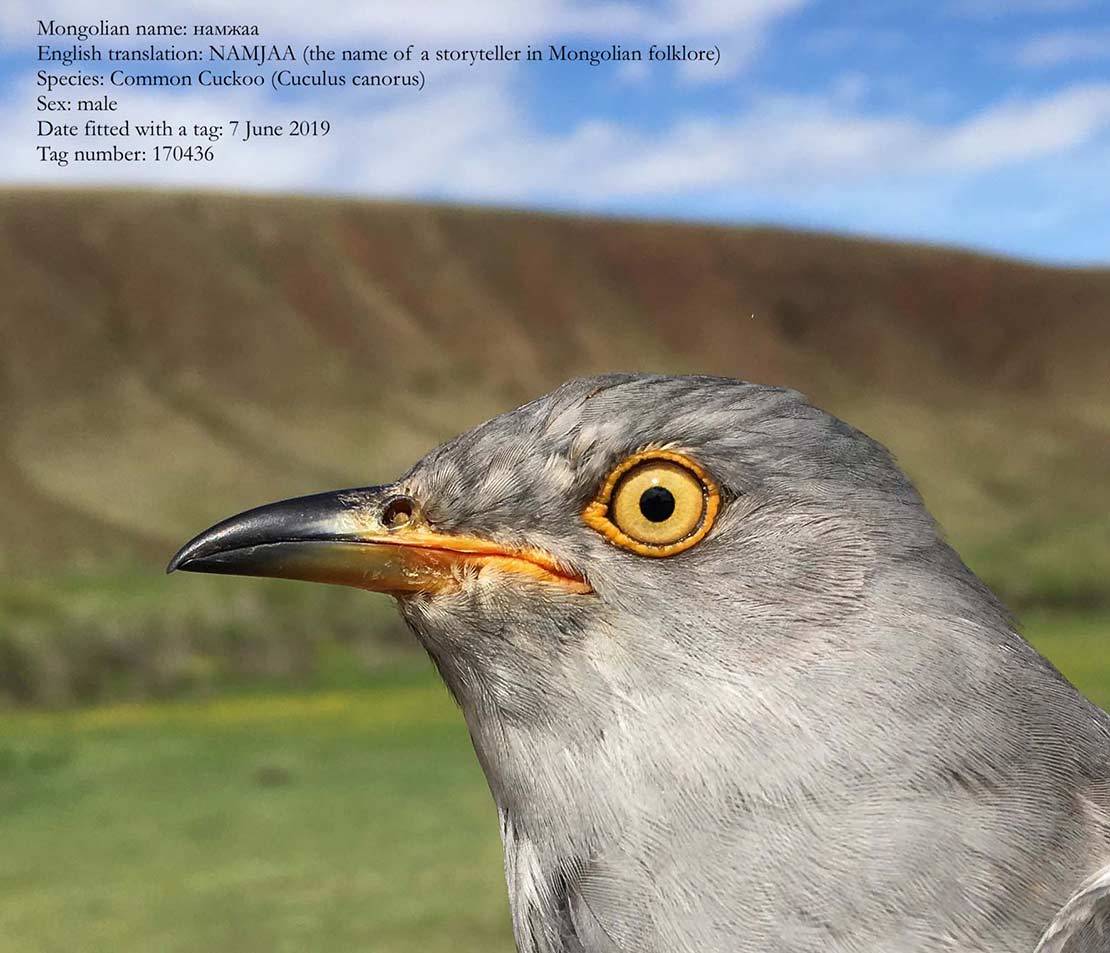
Recent advances in tracking technology have allowed scientists to understand the intricacies of bird migration like never before. Just a few decades ago only the largest birds such as albatrosses could be tracked, but with the continued miniaturisation of tags and increased battery power, even small passerines can be followed on their annual migrations. A greater understanding of bird migration routes will enable conservationists to develop, and implement, appropriate measures to conserve migratory species.
But it isn’t just about the science, as important as that may be. The use of satellite tracking technology can also be a powerful tool for connecting people across migratory flyways. A fantastic example of the ability to connect people is clearly demonstrated with some of the awareness raising work that is being undertaken alongside the scientific study of Cuckoo migration in Mongolia. Last year a team of researchers from Mongolia, China and the UK (migration studies even connects scientists!) tagged a number of Cuckoos in north-eastern Mongolia. The subsequent journeys that they have undertaken from Mongolia, through the Middle East and into Africa have led to some wonderful educational opportunities for schoolchildren along the route. Schoolchildren that are separated by thousands of kilometres, an ocean and a language have been connected by the incredible journey of migrating Cuckoos.
Read on and enjoy this wonderful story first posted by Terry Townshend on the Birding Beijing website.
Rob Sheldon
OSME chairman
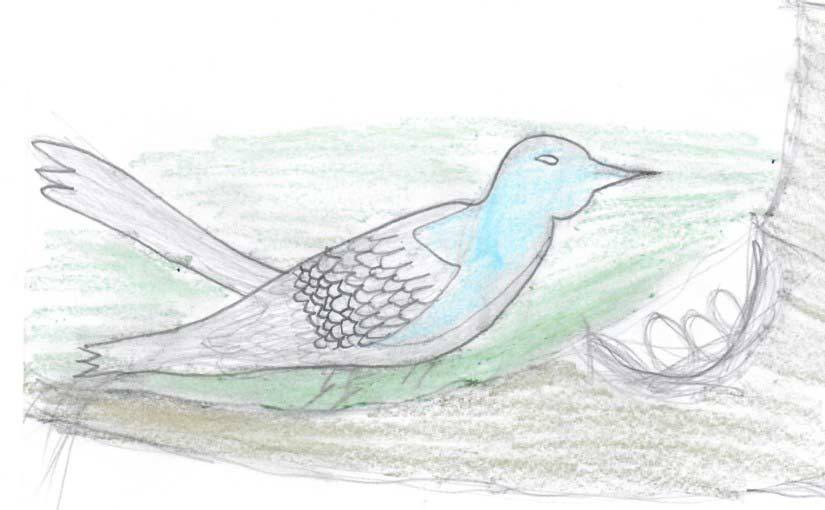
Unburdened by responsibility and blessed with a natural sense of wonder, children can be incredibly up-lifting! This week, I was delighted to receive news of an exchange of letters between schoolchildren in Mongolia and on Socotra Island, Yemen, about the Mongolian Cuckoos….
Back in June 2019, a team from the Wildlife Science and Conservation Center (WSCC) in Mongolia, the British Trust for Ornithology (BTO) and Birding Beijing visited Khurkh in northeastern Mongolia to fit transmitters to five cuckoos. A key part of the Mongolian Cuckoo Project was to visit local schools to raise awareness about migratory birds and invite the students to provide names for the cuckoos.
Since then, at least three of the five cuckoos have made it to Africa, crossing the Arabian Sea and, in the case of two, the Saudi Arabian desert, before settling in Zambia and Malawi for the winter (you can see the latest positions here).
On 27 November, one of the cuckoos named NAMJAA (Mongolian for “storyteller”), briefly stopped on Socotra, a Yemeni island in the Arabian Sea, some 240 kilometres east of the coast of Somalia and 380 kilometres south of the Arabian Peninsula.
Socotra is an isolated island and, as a result, home to a high number of species found nowhere else; up to a third of its plant life is endemic. In recognition of its unique flora and fauna, it was inscribed as a World Heritage Site in 2008. Socotra’s isolation also means that it is a magnet for migratory birds, in particular those crossing the Arabian Sea from India to Africa in autumn and we can be sure that NAMJAA was just one of many cuckoos crossing Socotra on that day.
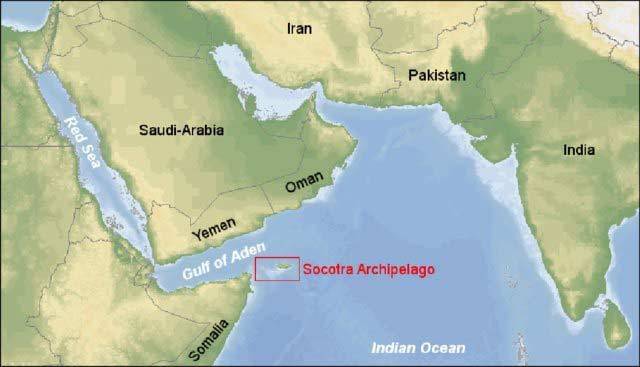
Learning that NAMJAA visited Socotra, schoolchildren in Mongolia decided to write letters to their counterparts on the island to thank them for the safe passage of “their” cuckoos and to tell them how important their island is, not only for the resident birds, but also for the millions of migratory birds that cross the Arabian Sea during their intercontinental journeys.
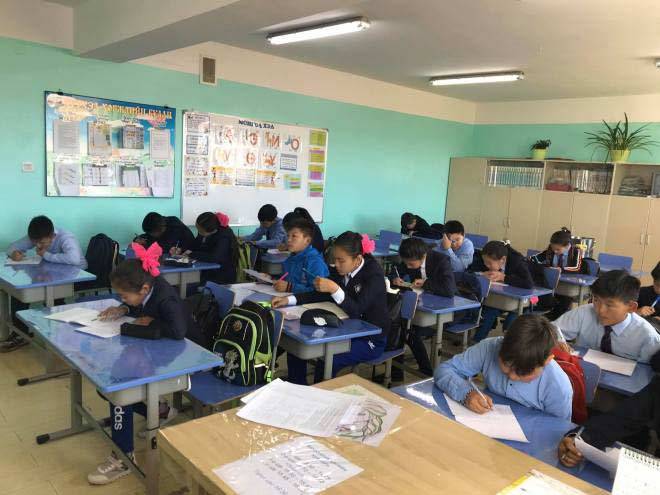
Letters from Mongolia

Dear Socotran school friends
My name is Dulguun B. I study in the 7th grade at the general education school of the Binder village of Khentii province. Thank you for visiting us and expanding our knowledge. Thank you for teaching us the names and their character of some birds. I hope you will protect many more birds in the future.
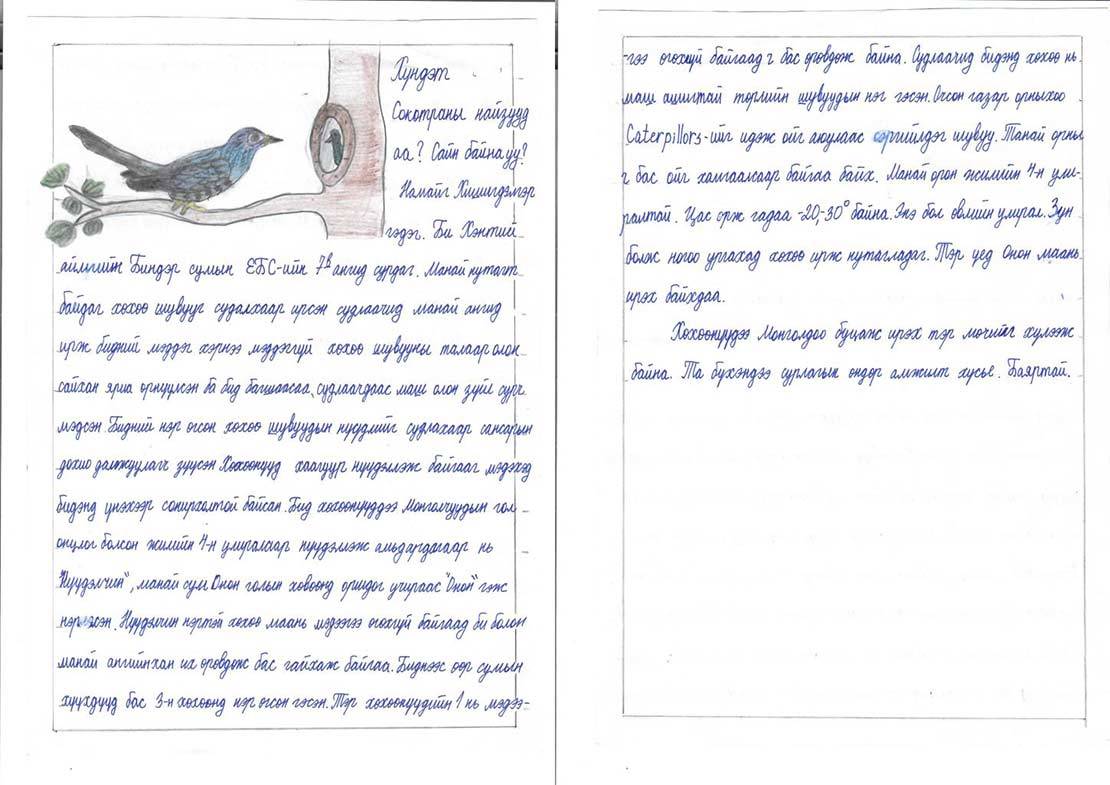
Dear Socotran school friends,
Hello friends, my name is Khishigdelger. I study in the 7th grade at the general education school of the Binder village, Khentii province. The researchers who came to study the cuckoo in our area visited us in our classroom and had a great talk about the cuckoo, a bird which we don’t know much. We learned a lot from our teacher and the researchers. It was very interesting to know the migration route of the cuckoos, to whom we gave their names and tagged by the researchers with satellite tags. We gave the name Nomad, because we Mongolians are nomadic and move every season of a year. We gave the name Onon, because of our village is located next to Onon river. The researchers said that the cuckoo is a very interesting bird and they eat caterpillars and protect forest. We believe they are also protecting forests in your country now. Mongolia has 4 seasons. At this moment it is snowing and cold outside, the temperature is somewhere between -20 and -30 Celsius. Because it is winter season here. I hope the cuckoos will be back in the summer. I’m looking forward to the moment when cuckoos returns to Mongolia.
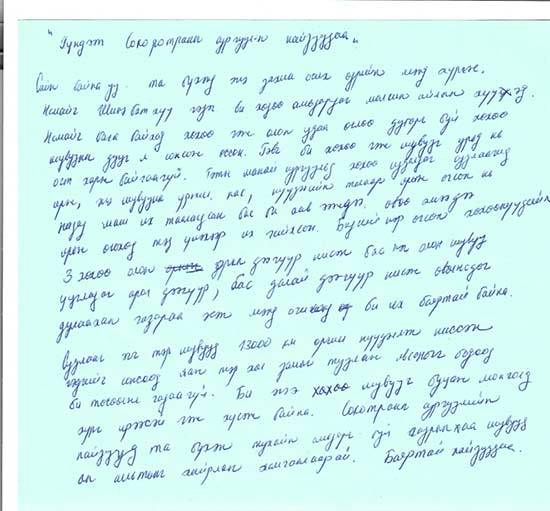
Dear Socotran friends
Hello my friends. My name is Shinekhuu. I live in the countryside and was born in a herder family. When I was a child, cuckoos used to sing almost every morning. But I have never seen a cuckoo! One day, researchers who study cuckoos visited us and they told a lot about cuckoos and their migration. I’m so glad to hear that the three cuckoos that we named have crossed the ocean and an island and then finally arrived a site where many birds gather, and they have survived to their wintering destination. I could not imagine how those birds traveled so far, having heard that they had traveled 13,000 km. I really want this bird to return to Mongolia. You should please take care of the birds and wildlife on the island of Socotra.
Best regard Shinekhuu, Binder village, Mongolia
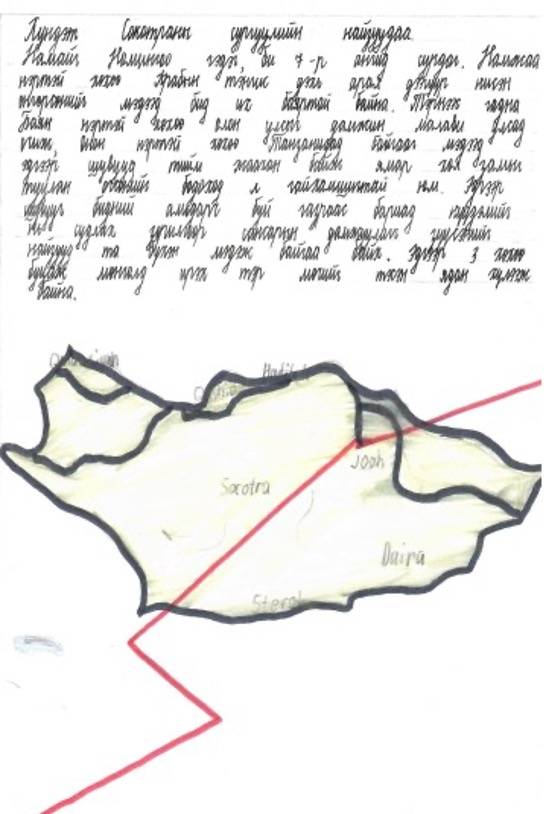
Dear Socotran school friends
How are you? My name is Nomingoo. We are delighted to know that Namjaa, the cuckoo, flew over your special island in the Arabian Sea. We also learned that the Bayan crossed many countries to reach Malawi and Onon is now in Tanzania. It is just amazing, to imagine how these little birds went that far. As you may know those birds were caught in Mongolia, where we live and fitted with a satellite tag, so we could track their long migration. We look forward to seeing these 3 cuckoos back in Mongolia.
We send our good wishes for 2020
Highschool, Binder village, Mongolia
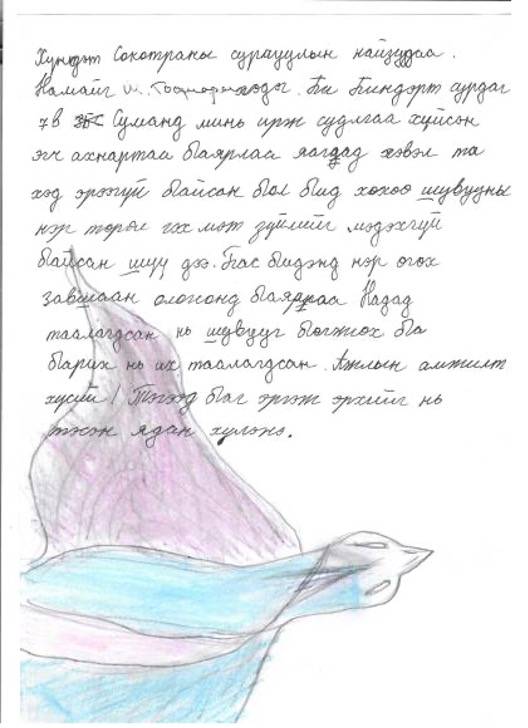
Dear Socotran school friends
Hello my friends. My name is Goomaral. I study in Binder village. Thank you to our researchers for coming to us. If they hadn’t come then we would not know about the birds, especially the cuckoo. Thank you so much for letting us know about the cuckoo’s migration. I liked how the satellite tag is used for studying migration. Good luck with your work. I’m looking forward to the moment when cuckoos return to Mongolia.
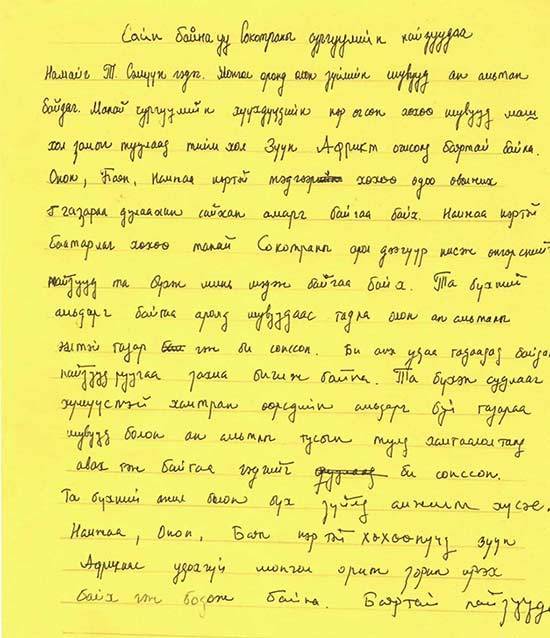
Dear Socotran school friends
I am Semuun. There are many species of birds and animals in Mongolia. I and my classmates are very pleased to give the name to the cuckoo that has come a long way to East Africa. Namjaa, Onon and Bayan cuckoos are probably having a great winter vacation. As you all may know, Namjaa cuckoo flew to your your beautiful island of Socotra in the Arabian Sea. I have heard that the island where you live is an important place for thousands of birds. I am writing a letter for the first time to my friends abroad. I heard about you and researchers are trying to protect this island. Good luck with your work and everything. We expect the Namjaa, Bayan and Onon cuckoos return to Mongolia soon from East Africa.
We wish you all the best for 2020
School children from Khurkh village, Mongolia
Just a few days later, schoolchildren on Socotra received the letters, read out by their teachers, and replied with their own letters and drawings.
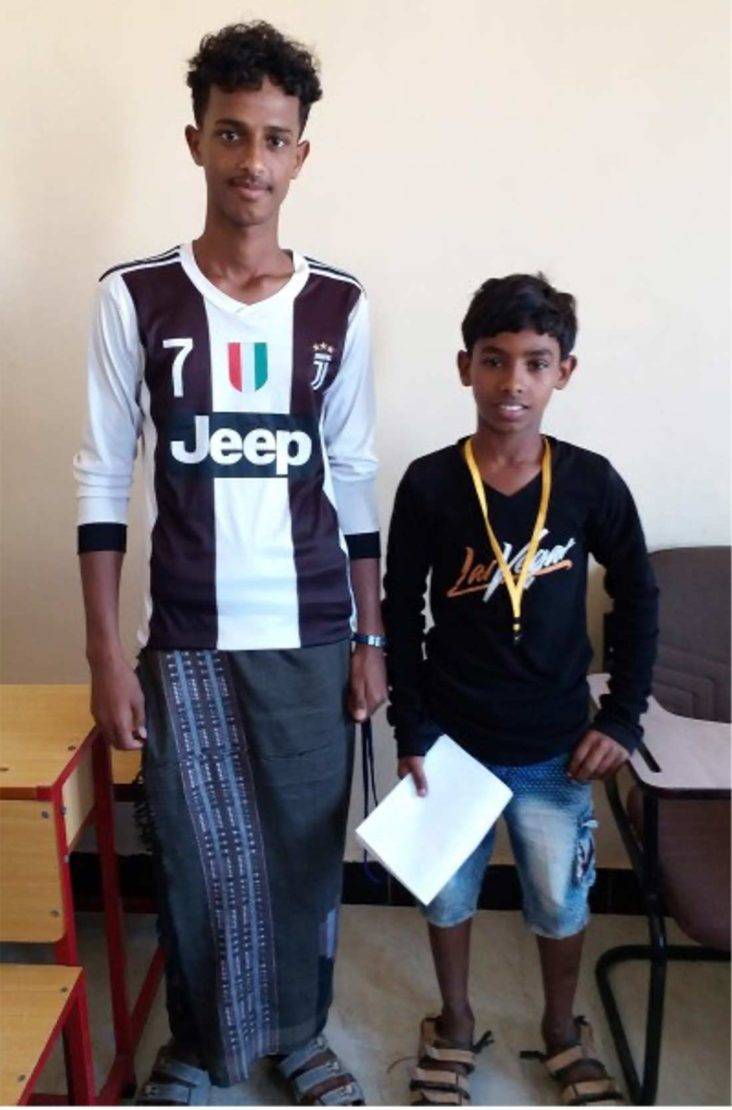
Replies from Socotra
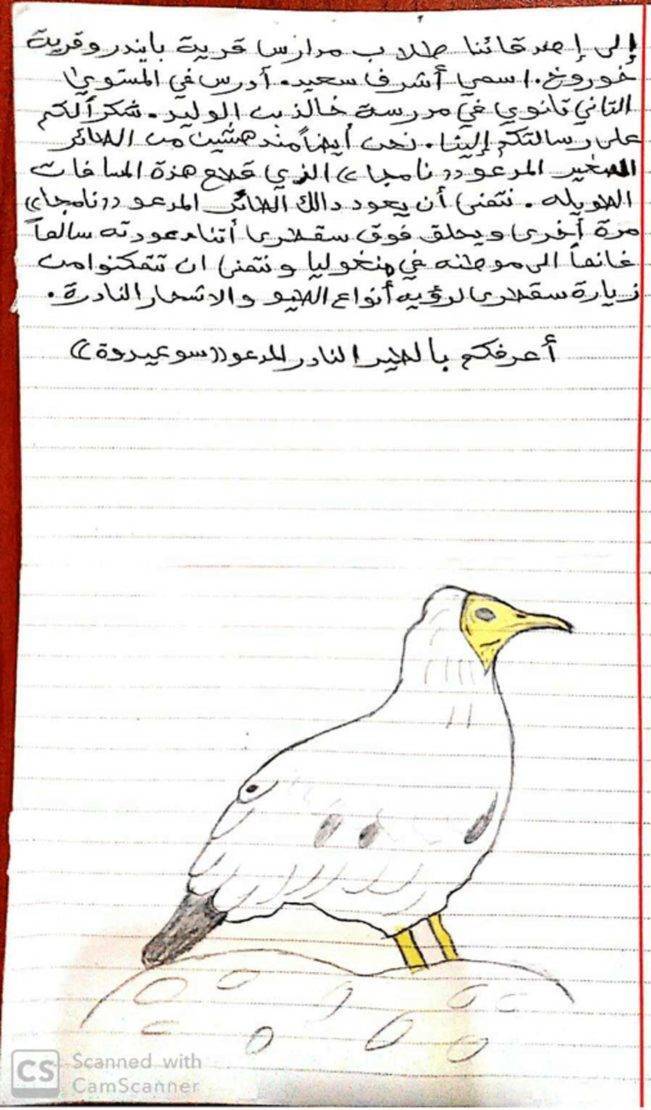
To our friends at Binder and Khurkh villages schools.
My name is Ashraf Saeed. I am studying in the second year at Khaled Ibn Al Waleed High School. Thank you for writing to us, we are amazed by the small bird “Namjaa” for travelling such long distances. We hope “Namjaa” will return safely and fly over Socotra on his way back home to Mongolia. I wish you can manage to visit Socotra one day and see its rare bird and plant species. Below is one of the interesting birds, Egyptian Vulture, called locally “Su’aidoo”.
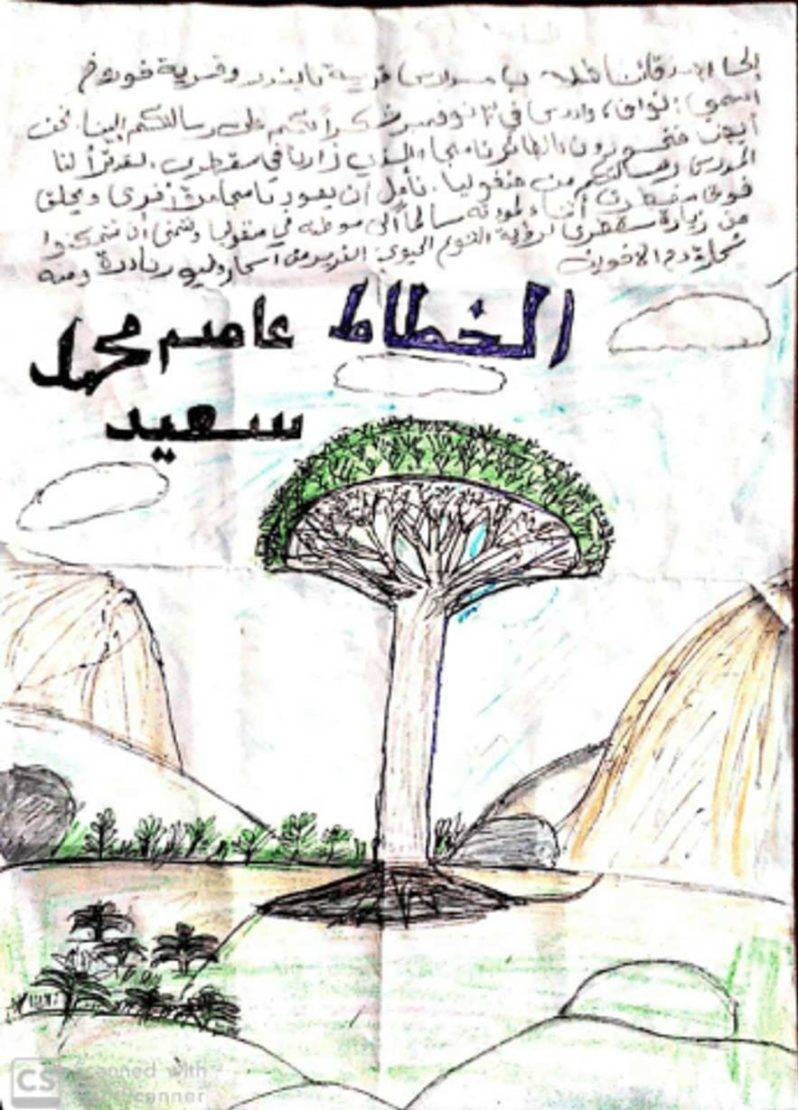
To our friends, school children in the villages of Binder and Khurkh.
My name is Nawwaf. I study at 30th November School in Hadibo, Socotra. Thank you for your letter, we are also proud of Namjaa who visited us in Socotra. The teacher read your letter from Mongolia. We hope Namjaa will return again and fly over Socotra on his way back to Mongolia. I hope you can visit Socotra and enjoy the unique biodiversity of trees and birds, such as the dragon blood tree. Drawing by Assim Mohammed Saeed.
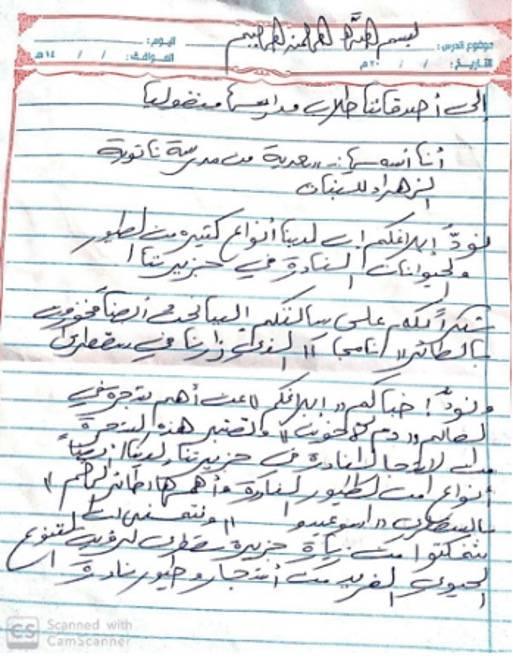
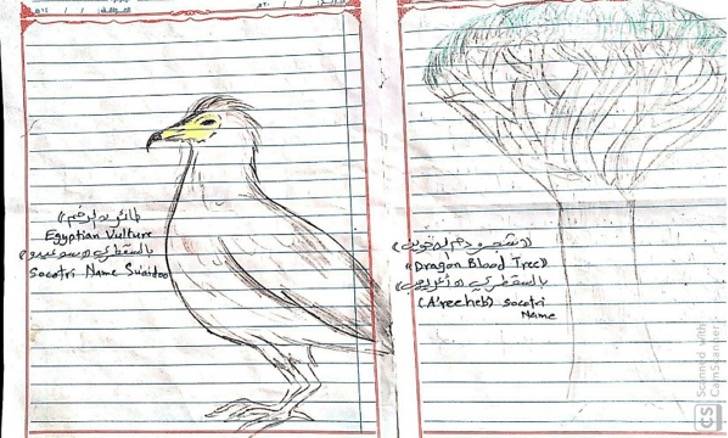
To our Friends students of Mongolia schools
My name is Sa’adiyah. I am a student at Al Zahra” secondary school for girls, Hadibo, Socotra. I would like to inform you that we have many species of rare birds and animals in our Island. Thank you for writing to us, we are also proud of the bird “Namjaa” who visited Socotra. We have a very special tree “Dragon Blood Tree” which one of the rare plants. We have also rare birds like the Egyptian Vulture, “Su’aidoo”. We hope you can visit Socotra and see the unique biodiversity of rare trees and birds.
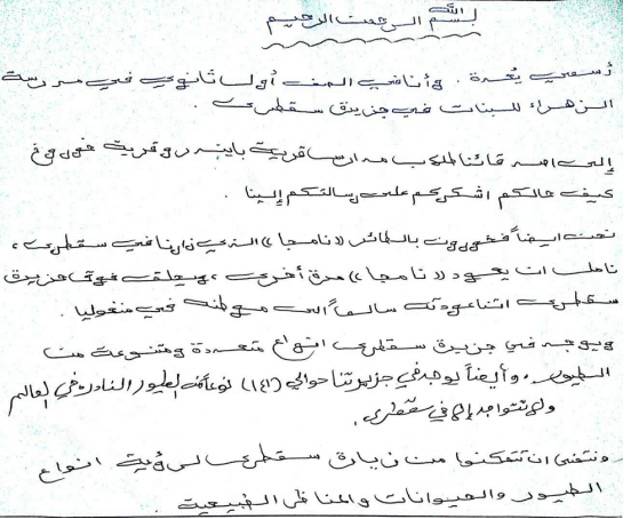
My Name is Yu’adah. I am in the first year at Al Zahra’a Secondary School for girls in Socotra Island. To our friends at Binder and Khurkh villages. How are you? I thank you for your letters to us. We are proud of the bird “Namjaa” who visited us in Socotra and we hope “Namjaa” will come back and fly over Socotra on his way back home in Mongolia. There are many species of birds on Socotra, about 141 bird species are found here. We hope you can visit Socotra and see all kinds of birds and animals and landscape.
Although Socotra is a World Heritage Site, conservation is understandably not high on the agenda given the ongoing civil war in Yemen and the resulting complete collapse of tourism, and it is hoped that these letters from far away Mongolia will help to raise awareness about the importance of the island to migratory birds and to support those working hard in difficult circumstances to try to protect the island’s key habitats. At the same time, the Mongolian children are learning about a part of the world with which they previously didn’t realise they were connected.
Richard Porter, author of Birds of the Middle East and Advisor to BirdLife International’s Middle East Programme, said:

The Mongolian Cuckoos are connecting countries, continents and people!
The Mongolian Cuckoo Project team is grateful to the Mongolian Wildlife Science and Conservation Society (WSCC), especially Tuvshinjargal Erdenechimeg, for facilitating the letters from Mongolia and to Richard Porter and Karim Nasher, one of Yemen’s leading conservationists, for arranging their delivery to schools on Socotra and for sending their replies.
